Ijraset Journal For Research in Applied Science and Engineering Technology
- Home / Ijraset
- On This Page
- Abstract
- Introduction
- Conclusion
- References
- Copyright
A Study on Compressive Strength and Micro Structural Properties of Magnesium Oxychloride Cement Concrete Under Varying Temperatures of Magnesium Oxide
Authors: Danthuri Karthik Goud, R. Sai Kiran, Hajarath Katukuri
DOI Link: https://doi.org/10.22214/ijraset.2024.58170
Certificate: View Certificate
Abstract
Construction is a huge consumer of natural resources and a considerable contribution in terms of CO2 emissions. Manufacturing cement and construction materials was shown t be source of the most greenhouse gas emissions. This study looks at whether magnesium oxychloride cement (MOC) may be used as a concrete alternative to standard Portland cement to lessen the environmental effect of the building sector. The research process involves a thorough review of the literature, an experimental investigation, and an internal structural analysis based on the optimal molar ratio. In this investigation, MOC cement concrete was mixed with magnesium powder at varied temperatures. The use of heated magnesium oxide powder produces the first set of results. Finally, a change was made to increase compressive strength of MOC cement concrete. To stimulate the reaction or gel formation, heat was applied to MgO powder at various temperatures and added to the manufacturing of MOC cement to improve the compressive strength. The molar ratio is chosen from the journal for optimum mixing and simple casting of concrete cubes. SEM and EDAX are utilized to analyze the microstructure of the various raised temperature samples. The MgO, phases 3 and 5, are apparent as double and triple ribbons with shared boundaries with water molecules and chloride anions in the SEM images, showing that the strength has increased due to these phases. EDAX shows the proportion of elemental weight in the sample.
Introduction
I. INTRODUCTION
A. General
Since the 1800s, plain Portland cement concrete has been widely used. According to study, each tonne of cement required releases around 0.9 tonne of CO2 into the environment, both directly during decomposition and indirectly as a result of the energy required during manufacturing. Currently, cement is estimated to contribute between 5% and 8% of worldwide CO2 emissions; 4.2 billion tonnes are produced each year, with a 2.5% annual increase rate.

To lower the carbon impact of ordinary Portland cement (OPC). Concurrently, byproducts of other industries such as flyash, silica fumes, magnesium oxide, and magnesium chloride have been employed as admixtures to replace the CO2-free cement component.
Strength is one of the advantages that arise. However, the presence of cement is required for the cementitious matrices to react and produce the binding material in concrete. Magnesium oxychloride is used to "activate" the unaccompanied cementitious matrix and restrict the cement's capacity to react.
Table 1.1: Comparing the chemical components of OPC and MOC
|
Components |
MOC percentage (%) |
OPC percentage (%) |
|
Magnesium (MgO) |
94.37 |
0.83 |
|
Lime (CaO) |
1.09 |
61.85 |
|
Silica (SiO2) |
2.95 |
20.07 |
|
Iron oxide (Fe2O3) |
0.34 |
4.62 |
|
Alumina (Al2O3) |
0.28 |
5.32 |
|
Sulfuric anhydrate (SO3) |
- |
2.50 |
|
Chloride content |
- |
0.0028 |
|
Factor of lime saturation |
- |
0.91 |
|
Ratio of alumina / Iron oxide |
- |
1.18 |
|
Ignition loss |
0.97 |
2.7172 |
OPC chemicals taken as per IS code 12269-1987 recommendations
B. Magnesium Oxychloride
Magnesium oxychloride cement (MOC), one of the low-carbon cement alternatives, has a high probability of replacing Portland cement due to its superior qualities, such as reduced CO2 emissions and lack of sticky drying. Low alkalinity, quick setting time, and great mechanical strength are further qualities that set MOC apart.
Sorel developed magnesium oxychloride (MOC) cement in 1867. It is an air-solidified gel composed of water (H2O), magnesium chloride (MgCl2), and magnesium oxide (MgO) that has been mildly burned.
- Magnesium chloride (MgCl2) sources and occurrence
For every ton of potassium chloride generated, 8-10 tons of magnesium chloride are produced as a byproduct. The materials were obtained from Sreshtavi Enterprise in Jeedimetla and shipped from Mayuri Chemicals in Gujarat.
2. Magnesium oxide (MgO) sources and occurrence
Dolomite (CaMg(CO3)2) is a valuable calcium and magnesium resource on Earth. Dolomite is a raw material that can be used to make magnesium cement. It was shipped from Tanmag in Tamil Nadu, and I obtained magnesium oxide from Sreshtavi Enterprise in Jeedimetla.
C. Objective of work
The major purpose of this research is to measure the compressive strength of magnesium oxychloride cement concrete for m20 grade concrete by altering the temperatures of magnesium powder. Which temperature produces the most strength compared to standard Portland cement, and to examine the interior structure of the cube using SEM and EDAX.
As a result, in order to fulfill the goal, the work was completed in the steps listed below:
- The molar ratio of MgO: MgCl2:H2O used in the study determined by Wen Jing et al.(2013).
- Cubes measuring 150x150x150 mm3 were cast in sufficient quantities during the second phase and allowed to cure outside for 7, 14, and 28 days.
- During the third stage, the cubes had tested using a compressive testing machine to see if there were any problems or changes that needed to be made, and experimental work was carried out appropriately.
- If the compressive strength of MOC cement concrete is less than that of OPC cement concrete in the fourth phase, the method is repeated and the temperature is raised until the compressive strength of MOC cement concrete is more than that of OPC cement concrete.
- Finally, the internal structure of the examined specimen is evaluated for 28 days samples using SEM and EDAX.
D. Organization of Thesis
There are five chapters in the thesis. The present thesis project’s aims and parameters are briefly discussed in the first chapter. This includes an introduction to MOC cement concrete, the source of, material origin and extraction, the scope of the current effort, gaps discovered in the literature, and the work’s purpose.
The second chapter presents a literature review organized into three divisions, including a review of literature on comprehensive studies and a review of literature on experimental work.
The third chapter outlines the many types of materials utilized, their qualities, and the physical tests performed on the materials to let us handle them with ease. The sequential process for filling gaps detection in the literature review, which includes experimental work done to achieve the study aim, is provided in fourth chapter.
The fifth chapter explains the state of the work done and discusses the outcomes of the experimental work done by performing several physical tests on concrete. In chapter six, microstructure analysis is done to analyze the shape of concrete specimens, damage produced, and factors responsible for the strength of MOC cement concrete using SEM and EDAX methods.
The seventh chapter deals with the paper’s concluding results, which provide a thorough summary of the current study based on the experimental work done. The last chapter contains references for drawing the aim and completing the thesis work efficiently.
II. LITERATURE REVIEW
A. Introduction
The research publications on the issue have been classified into three categories: literature on experiment study, literature on experimental work, i.e. thorough studies of MOC cement concrete using SEM and EDAX analysis, and literature on magnesium cement kinds utilizing analysis. Each study is briefly described in the next section.
B. Literature on experimental studies
The first group of literature reviews involves experimental studies conducted by different researchers on the magnesium oxychloride cement in concrete, and its various application and properties have been studied.
A K Misra et al., (2007) The flexural and compressive strengths of magnesium oxychloride (MOC) cement, which is used in concrete projects, were examined in this study. A variety of metrics, including scratch resistance, compressive strength, and flexural strength, were studied for different MOC cement concrete compositions with varying strengths that contribute to good placement and finishing attributes. The study also assessed the MOC concrete compositions' resilience to high temperature variations, freezing and thawing, wetting and drying, and salt deposition. With a compressive-flexural strength range of 6-8, the results showed that MOC concrete has a high flexural-to-compressive strength ratio.
Hongxia Qiao et al., (2014) have presented a comprehensive study on the applications of magnesium oxychloride cement due to its flaws, which include ease of building and poor water resistance, as well as its high strength, light weight, and strong abrasion resistance. But also describes the state of domestic research on magnesium oxychloride cement and its promising future development.
Hao Sun et al., (2018) has investigated the characteristics of magnesium oxychloride cement experimentally. This teaches us the MOC cement is superior to OPC concrete in terms of strength and folding pressure. It also adds an organic solution to provide design and processing guidelines for future MOC cement component design.
C. Literature On Experimental Work
The second group of literature reviews includes experimental work on magnesium oxychloride cement conducted by various researchers. The experimental work was carried out by substituting magnesium oxychloride cement for normal cement and investigating its strength, durability, workability, and mechanical properties.
Chenggong Chang et al., (2018) have presented an experimental study using magnesium slag and hydrochloric acid to prepare magnesium oxychloride cement. The compressive test for MOC cement is performed after 3days, 7days, and 28days. MOC may have a high early strength if its hydrochloric acid content is high. The composition and activity of magnesium slag calcined at various temperatures were investigated using XRD and hydration methods.
Qing Huang et al., (2022) have presented a comprehensive investigation of replacing magnesium sulphate with magnesium chloride in magnesium oxychloride cement. The effects of replacing magnesium sulphate water with magnesium chloride on the setting time, compressive strength, and water resistance of MOC cement.
Prior to replacing magnesium chloride with 5Mg (OH)2.MgCl2.8H2O, the addition of sulphate reduces the magnesium concentration of the water phase by 30%. After replacing with magnesium sulphate, the phase becomes 5Mg (OH)2.MgS O4.7H20. Mixing varying mass fractions of magnesium sulphate solution with MOC resulted in a composite gelling system composed of magnesium thioxide and chlorine. The phase composition and micromorphology of the hydration products in the mixed system of magnesium thioxide and chlorine, which was created by combining various mass fractions of magnesium sulphate solution with MOC, were investigated using XRD and SEM.
Michel Lojka et al., (2021) Composite materials were developed and assessed with additions such as multi-walled carbon nanotubes (MWCNTs) and magnesium oxychloride cement (MOC). The composites containing 0.5 and 1% MWCNTs were compared to pure MOC phase 5 references. Several analytical techniques were employed to determine the phase and chemical composition, morphology, and thermal behaviour of the composites. After 14 days, the composites' fundamental structural properties, pore size distribution, mechanical strength, stiffness, and hygrothermal performance were all evaluated. MWCNT-doped composites have high compactness, higher mechanical resistance, stiffness, and water resistance, all of which are critical for their use in the building industry as well as the future design and development of substitute building materials.
Amal Brichini et al., (2016) Several parameters were tested to see how they affected magnesium oxychloride-containing cement. It has been demonstrated that using experimental design to determine the ideal experimental conditions is extremely advantageous in the development of a superior cement mix. The operational parameters were predicted and optimised based on stirring speed, mixing time, mass ratio of magnesium chloride/magnesium oxide, percentage of silica glass powder (SGP), and SGP partial size. Responses were tested using compressive strength and setting time. Scanning electron microscopy was utilised to assess morphological aspects, x-ray diffractograms to assess MOC phase compositions, and differential thermal analysis of thermogravimetric analysis to analyse phase decomposition. It was demonstrated that using SGP can boost MOC's water resistance by forming forsterite, which can decrease the decomposition of phase 5 and prevent the synthesis of brucite in water.
Milena Pavlikova et al., (2022) The project aims to create lightweight composites with moderate strength and improved thermal performance. The composites' properties were assessed as part of the experimental study, which also included the usage of magnesium oxychloride and increased wood chip ash. Foamed glass was used as a lightweight aggregate to create materials with high porosity and mechanical strength, moderate water absorption, low thermal conductivity, and large heat storage capacity. Wood chip ash was added to the composites to improve mechanical strength and provide construction materials with less negative environmental impact. When environmentally friendly and sustainable construction materials are required, these composites could be an intriguing alternative to Portland cement-based composites.
Chuanlin hu et al., (2015) has examined the phase 5 reaction product's micromechanical characteristics experimentally in the magnesium oxychloride (MOC) cement system. Researchers used scanning electron microscopy methods and nanoindentation to determine that phase 5 (5MgOH2.MgCl2.8H2O) had an average indentation modulus of 32.5 ± 4.2 Gpa and an average hardness of 1.03 ± 0.19 Gpa. The study also found a relationship between the MOC cement paste's elastic modulus on the micro-and micro-scales, which may be used to estimate the material's macroscopic elastic modulus.
Anna-marie lauermannova et al., (2021) Conducted the research on magnesium oxychloride cement, which is environmentally friendly and has good mechanical properties. The diatomite composite is investigated in this work. Three phases were created using various approaches and tested with different quantities of diatomite. Along with structural, mechanical, hydrophilic, and thermal properties, the study investigated phase, chemical composition, morphology, and thermal behaviour. This environmentally friendly material has remarkable mechanical properties, making it suitable for demanding conditions and with exciting application possibilities.
N.Clament Sagaya Selvam et al., (2011) has done an excellent job with his experiments on producing MGO using microwave-assisted burning. Next, the finished product was placed next to MGO, which was created in the traditional way. A comprehensive research using XRD, FT-IR, HR-SEM, TEM, EDX, DRS, and PL spectroscopy was conducted, yielding findings and results. The FT-IT method was utilised to investigate how water and CO2 adhered to the MGO surface and confirmed the formation of the MGO phase. The XRD results confirmed the formation of cubic-phase MGO. The formation of MGO microcubes and nanosheets was demonstrated, and HR-SEM and TEM were utilised to explain how they could develop. Scientists utilised DRS and PL spectroscopy to determine how much light was absorbed and emitted by the grid.
Wen Jing’s et al., (2013) To strengthen TDMOC cement and make the maximum use of salt lakh's magnesium supply, researchers investigated how citric acid affected the hydration process and mechanical qualities of the cement. Citric acid was observed to slow down the second peak of TDMOC, reduce heat release, and produce more 5Mg(OH)2.MgCl2.8H20 and less Mg(OH)2 during the hydration process. The microstructure revealed tiny, perfect crystals.
Pan Liu et al., (2021) was examined for the characteristics of magnesium residue at various temperatures during calcination. Rather than using light magnesium oxide, magnesium residue from salt lakhs can be used to make magnesium oxychloride cement (MOC). Different magnesium chloride solutions and calcination temperatures were used to create MOC specimens. MOC cement is strengthened by utilising a high concentration of magnesium chloride solutions. Magnesium oxychloride cement has the potential to be a long-term alternative for Portland cement materials, lowering pollution levels and mitigating the construction industry's negative environmental effects.
Chenggong chang et al., (2022) It is beneficial for both the environment and the economy to investigate the usage of magnesium chloride resources in the form of magnesium oxychloride cement. However, the specific impact of high temperatures on cement is uncertain. The study sought to evaluate the effects of calcination temperature on the phase composition, microstructure, and mechanical properties of cement. Flexural strength decreased by 57.07% after calcination at 1000°C, whereas compressive strength remained constant. The MOC cement retained its high compressive strength (67.7 Mpa) after calcination at 4000C. However, the cement totally lost its compressive and flexural strengths when the calcination temperature was raised to 4500C.
D. Literature On Types Of Magnesium Analysis
Yuanji chen et al., (2018) The effect of Portland cement on magnesium oxysulfate (MOC) cement was investigated using an experimental approach. We used parameters such as setting time, compressive strength, cement mortar flexibility, x-ray diffraction, scanning electron microscopy, and the rate at which the cement hydrates and releases heat. The results showed that the mechanical strength of MOC cement is significantly reduced when Portland cement is added. However, adding a small amount of portland cement might decrease the setting time while maintaining maximum compressive strength.
Xiangchao Zeng et al., Magnesium sulphate cement is a lightweight, quick-setting, long-lasting, and wear-resistant magnesium-based cementitious material that has undergone laboratory testing. It could be used for building insulation as well as groundwork. BMS offers 2.5 times the flexural strength of Portland cement in the same strength class, as well as comparable durability and reinforcement protection. This essay examines how BMS is formed and hydrates, as well as how various factors might alter its microstructure and properties.
Baki Aykut Bilginer et al., has conducted studies to examine the advantages of magnesium potassium phosphate cement (MKPC) over regular Portland cement, including strength gain and quick setting. Although the effects of mixture proportioning on MKPC paste have been studied, there are conflicting reports on how magnesia calcination, parameters such as the magnesium-to-phosphate ratio (m/p) and water-to-binder ratio (w/b), added materials such as fly ash and borax, and sand addition influence mineralogy and properties such as setting and strength. The factors are evaluated on paste samples using scanning electron microscopy, thermogravimetric analysis, and X-ray diffraction over a relevant range of values. The increase of strength can be measured using both pastes and mortars. Calcination of magnesia produces some forsterite with impurity SiO2, which may be related to reactivity decrease. As W/B increases, the setting rises.
E. Summary of Literature Review
The majority of studies show that utilising light-burned magnesium powder instead of conventional Portland cement increases the compressive strength of magnesium oxychloride cement concrete at various molar ratios. However, there is little written about the subject. So, the purpose of this research is to determine the strength of magnesium powder by varying the temperature and utilising it instead of M20-grade OPC cement concrete.
III. MATERIAL PROPERTIES
A. Introduction
This chapter describes the many materials utilized and the various tests are done to facilitate the process. This will help us understand the qualities and applications of materials.
B. Materials
- Magnesium Oxide: Magnesium oxide is a solid white mineral that forms naturally as periclase. It is an artificial magnesium salt that can dissolve in water. The general formula for it is made up of oxygen and magnesium ions.
- Magnesium Chloride: Magnesium chloride, also known as MgCl2, is a type of inorganic chemical. When mixed with water, it forms hydrates of MgCl2.nH2O, where the value of n can range from 1 to 12. These compounds are colorless or white solids that dissolve easily in water. They have a wide range of practical applications due to their natural occurrence.
- Fine aggregate: Fine sand or crushed stones are usually used for making fine aggregates. These particles are usually small enough to pass through a less than 4.75 mm sieve.
- Coarse aggregate: Coarse aggregate are the big chunks of material we use in construction and concrete. They can be anywhere from 0.075 mm or 75 microns to 80mm, but usually they are between 4.75 and 10mm. most of the time, we use gravel for the coarse aggregate, but sometimes we use crushed stone.
- Water: The chemical name for water is H2O. Water is clear, odourless, tasteless, and almost colourless.
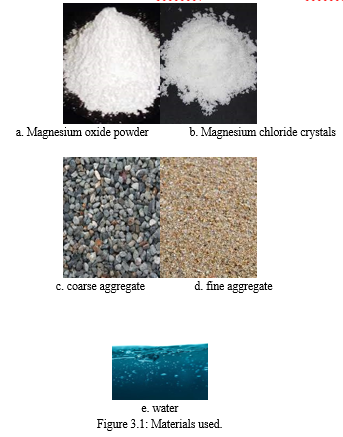
C. Properties Of Materials
The physical characteristics of several materials utilized in the study are determined and reported here.
- Physical Properties
a. Properties of Magnesium Oxide (MgO)
Magnesium oxide, represented by the chemical formula MgO, exhibits several important characteristics that define its properties and uses. With a molecular mass of 40.30 g/mol, it consists of one magnesium atom (Mg) and one oxygen atom (O). This composition gives it a density of 3.59 g/cm³, indicating a tightly packed atomic structure within the substance. Magnesium oxide has a melting point of 714°C, which signifies the temperature at which it transitions from a solid to a liquid state. Furthermore, its boiling point is at 1090°C, marking the temperature at which it transforms from a liquid to a gaseous state. These properties make magnesium oxide valuable in applications such as a refractory material in high-temperature processes and as a component in various ceramics, where its stability and physical properties play crucial roles.
Top of Form
b. Properties of Magnesium Chloride (MgCl2)
Magnesium chloride (MgCl2) is a chemical compound with a molar mass of 95 g/mol, composed of one magnesium (Mg) atom and two chlorine (Cl) atoms. It exhibits a density of 2.32 grams per cubic centimeter (g/cm³), indicative of its relatively close atomic packing in a given volume. The boiling point of magnesium chloride is notably high, reaching 1411 degrees Celsius (°C), and it undergoes a phase change from solid to liquid at this temperature. Conversely, the melting point occurs at 714°C, marking the transition from a solid to a liquid state. These distinct properties make magnesium chloride valuable in various applications, including as a de-icing agent to melt snow and ice on roads, in the pharmaceutical industry for medicinal purposes, and in the production of magnesium metal through chemical processes.
Top of Form
c. Fine Aggregate
- Density of fine aggregate 1450 - 2082 kg/m3
- Specific gravity- 2.6
- Water absorption less than 3%
- Moisture content is 0-5%
d. Coarse Aggregate
- Density of coarse aggregate is 1450 - 2082 kg/m3
- Specific gravity – 2.68
- Water absorption – 0.5 - 1%
- Moisture content - 0.2 - 4%
e. Water (H2O)
Water (H2O) is a remarkable and ubiquitous substance with a wide range of unique properties. One of its most distinctive features is its ability to form hydrogen bonds between its molecules. These bonds arise from the partial positive charge on hydrogen atoms and the partial negative charge on oxygen atoms, resulting in strong intermolecular forces that give water its exceptional properties. Water's melting point at 0°C and boiling point at 100°C, under standard atmospheric pressure, are defining characteristics that allow it to exist in three primary states: solid, liquid, and gas. In the solid state, water forms ice, typically at temperatures below 0°C. In its liquid form, water is the most common state we encounter, with its temperature usually ranging from 0°C to 100°C. When heated above its boiling point, water transforms into a gaseous state, known as water vapor.
f. Portland cement
- Density of OPC is
- Specific gravity of cement – 2.84
- Normal consistency of cement is 29%
- Initial setting time – 30 min
- Fineness of cement is 6.66%
D. Mix Design Calculations
- MOC cement molar ratio is 5:1:8, which means for 5 times magnesium oxide, 1 time magnesium chloride, and 8 times water. This ratio holds on to the different temperatures of magnesium powder used in MOC cement. The molar ratio shown above is from Win Jing’s (2013) publication.
- We used the M20 concrete grade in a 1:1.5:3 ratio, where: 1 part OPC cement, 1.5 parts fine aggregate, 3 parts coarse aggregate.
- For M20 grade concrete, MOC cement completely replaces OPC cement.
- Sample calculation
- The MOC cement concrete is prepared with mix proportion 1:1.5:3 which is same as M20 grade concrete.
- Where ‘1’ represent MOC cement, ‘1.5’ represents Fine Aggregates, ‘3’ represents Coarse Aggregate.
- To get MOC cement , as it is prepared from magnesia, MgCl2 and water the following proportions are used 5:1:8 which is obtained from Win Jing’s (2013) publication.
2. Quantity of material required for one cube of size 150mm x 150mm x 150mm
- Quantity of Magnesium Oxide (MgO)
- The magnesia quantity will be obtained from mix proportion of 5:1:8
- From where, 5 part of MgO can be obtained from = weight of MOC cement required for one cube / 5+1+8 = 1.05/14 = 0.075 x 5 parts of MgO = 0.375 kg
- But,
Weight of MOC cement required for one cube will be obtained from mix proportion of M20 (1:1.5:3) as = volume of cube/5.5 x ratio of cement = 0.00337 / 5.5 x1 = 0.006 x density of MOC cement = 0.0006 x 1750 = 1.05 kgs
- Here,
“0.00337” is the volume of one cube in m3.
“1750” is the density of MOC cement in kg/m3.
3. Quantity of Magnesium Chloride (MgCl2)
- One part of MgCl2 = weight of MOC cement required for one cube / 14 x 1 = 1.05 / 14 x 1 = 0.075 kg
4. Quantity of Water (H2O)
- 8 parts of H2O = weight of MOC cement required for one cube / 14 x 8 = 1.05 / 14 x 8 = 0.6 liter
5. Fine aggregate:
- Density of fine aggregate = 1800
- Volume of one cube = 0.0033 cum
- Volume of fine aggregate in one cube = 0.0033/5.5*1.5*density of fine aggregate (1800) = 1.62 kg
6. Coarse aggregate:
- Density of coarse aggregate = 1850
- Volume of cube = 0.0033 cum
- Volume of coarse aggregate in one cube = 0.0033/5.5*3*density of coarse aggregate (1850) = 3.33 Kg
7. From above calculations the quantity required for 1 MOC concrete cube
- Magnesium oxide (MgO) = 375g
- Magnesium chloride (MgCl2) = 75g
- Water (H2O) = 0.6 lit
- Fine aggregate = 1620g
- Coarse aggregate = 3330g
8. Sample calculations for 12 cubes
- Mgo = 375*12 = 4500g
- MgCl2 = 75*12 = 900g
- Water = 0.6*12 = 7.2 lit
- Fine aggregate = 1620*12 = 19440g (19.44) kg
- Coarse aggregate = 3330*12 = 39960g (39.96) kg
9. Ratio of OPC cement: 1:1.5:3
- Density of Ordinary Portland Cement (OPC) =1440 kg/m3
- Volume of one cube = 0.15*0.15*0.15 = 0.0033 m3
- Quantity of cement required for one cube = volume of cube (0.0033)/1+1.5+3*1 = 0.0006* density of OPC cement (1440) = 0.864 kg for one cube
- Fine aggregate = 1.62kg
- Coarse aggregate = 3.33kg
IV. CASTING AND CURING
A. Introduction
This chapter discusses the process of batching materials based on the concrete ratio obtained from the journal. The stage involved in achieving this goal include determining the physical parameters of magnesium oxide and casting the concrete, following by curing the concrete cubes and evaluating them for their compressive strength.
B. Methodology
STEPS INVOLVED: Compressive strength of MOC cement concrete comparing with M20 grade OPC cement concrete cubes.

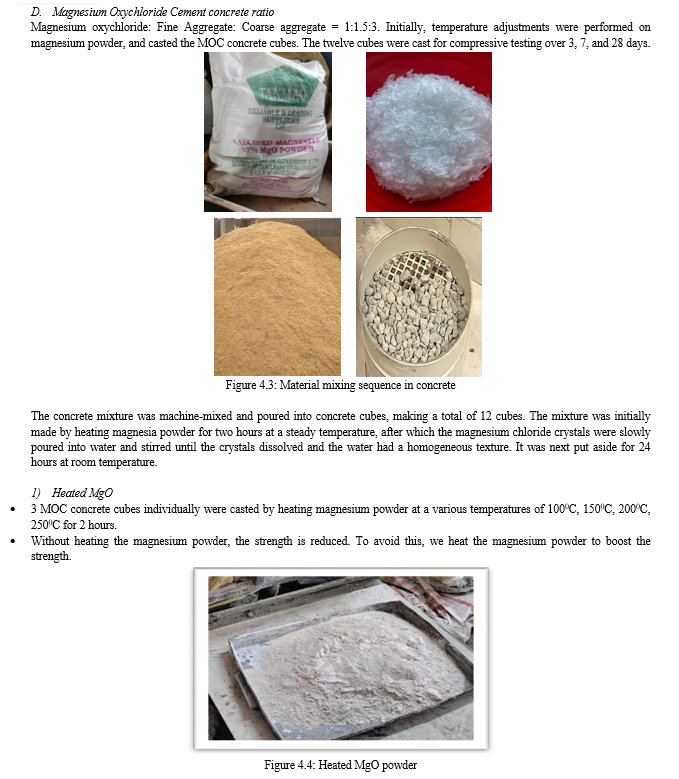
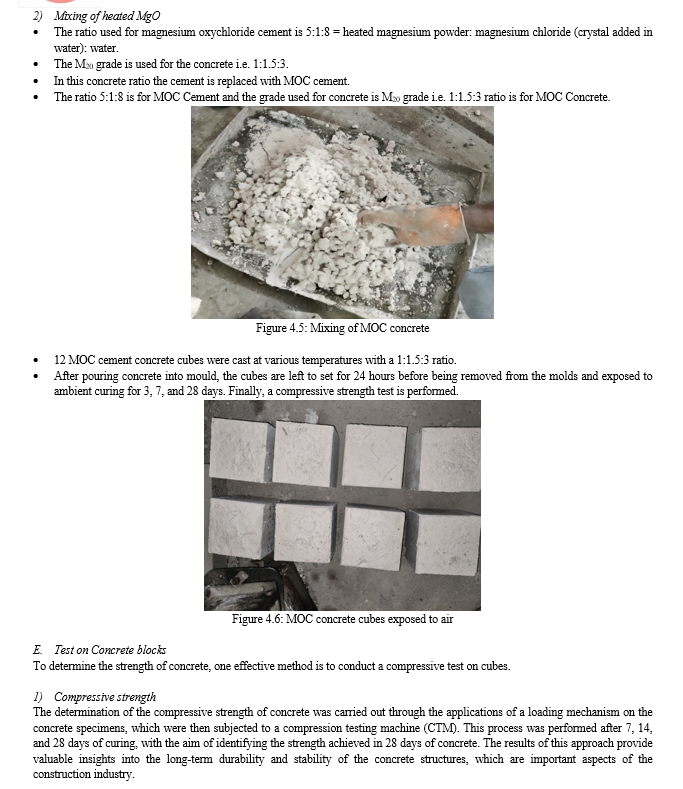
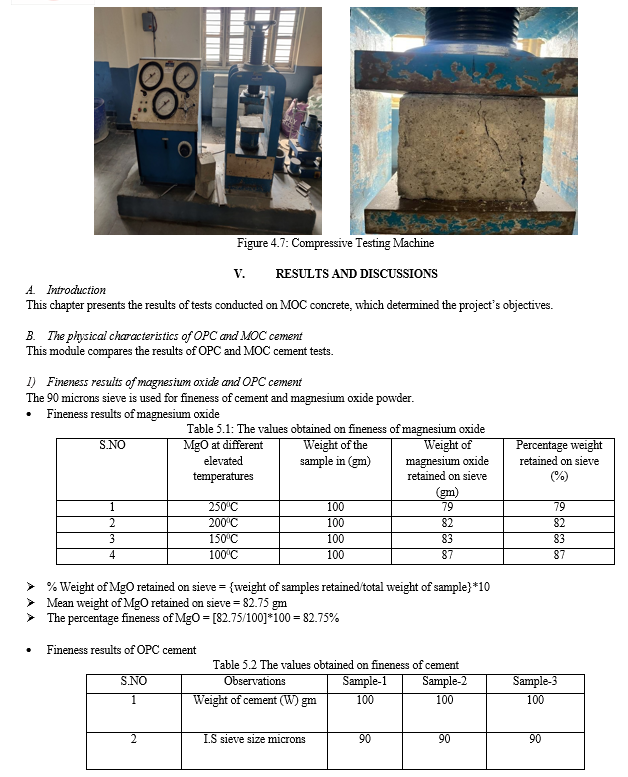
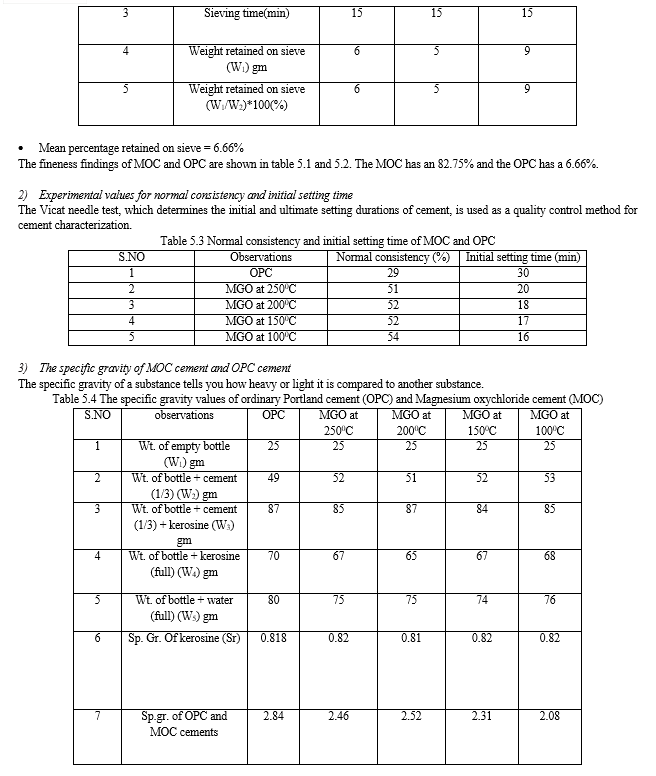
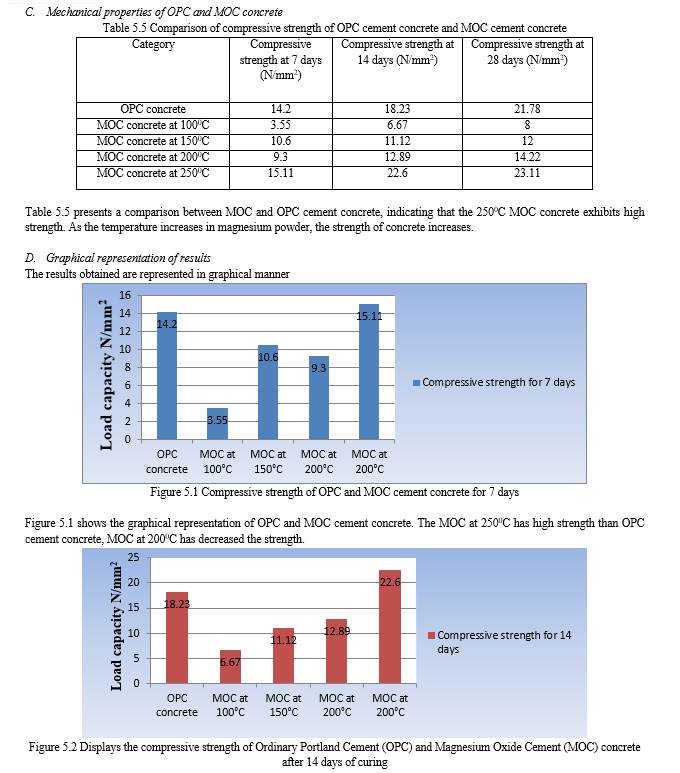

The graphical representation shown in figure 5.4 illustrates the compressive load of MOC cement concrete cubes after 7, 14, and 28 days, which were made using heated magnesium oxide powder at different temperatures. The comparison was made with OPC cement concrete. It was observed that the compressive load increased with the increase in temperature of magnesium oxide powder. At a temperature of 2500C, the MOC cement concrete showed greater strength than the OPC cement concrete.
E. Summary of Results
This module contains a detailed account of the results obtained from the experimental work. The task at hand involved a series of producers, including casting and curing of concrete cubic specimens, followed by mechanical testing using varying temperatures of magnesium oxide powder. The samples were prepared in accordance with the M20 grade, which entailed using a ratio of 1:1.5:3 = 5MgO : MgCl2 : 8H2O. It is worth noting that by replacing OPC cement with MOC cement at a temperature of 2500C, the grade M20 can be significantly strengthened. The findings of this experiment are critical in the field of construction and will aid in developing more robust and long- lasting structures.
VI. MICROSTRUCTURE ANALYSIS
A. Introduction
Microstructure analysis is a method of examining the internal composition of an object through microscopic examination. The microstructure of a solid material is determined by the size, shape, and distribution of its various phases. Structures that are visible to be naked eye fall under the macrostructure category, while those that are smaller than 200µm are classified as microstructures. Microstructure analysis is a microscopic study used to determine the internal structure of a specimen. The electron microscope, which has a capacity of up to ten times magnification and potentially more, can be used to identify morphology, internal processes, and tiny particles such as voids, pores, and internal cracks present in the specimen. It is useful in determining any structural damage to the structure. Several techniques such as Scanning Electron Microscopy (SEM), X-Ray Diffraction (XRD), Energy Dispersive X-Ray Spectroscopy (EDAX), Fourier Transform Infrared Analysis (FTIR), White Light Interferometry (WLI), are used to analyze microstructures. In this study, microstructure investigation was carried out using SEM and EDAX methods.
B. Scanning Electron Microscopy (SEM)
Scanning Electron Microscopy (SEM) is a high resolution imaging technique used to analyze the microstructure of a sample. A sample is exposed to a stream of highly charged electrons, which eject secondary electrons. These secondary electrons are gathered using a detector that surrounds the sample and converted into a signal that can be processed by a computer. SEM products highly detailed images that can reveal the structure of a sample at a very high resolution, making it a powerful tool in materials science, engineering, nanotechnology, biology, and other fields.
The images displayed below showcase various sizes, shapes, and structures, each representing different characteristics. These SEM images depict the microstructure of MOC cement concrete, where the ideal molar ratio of MgO: MgCl2: H2O is 5:1:8. The concrete has been subjected to temperature variation, where heated (2500C) magnesium oxide powder is used, resulting in high compressive strength.

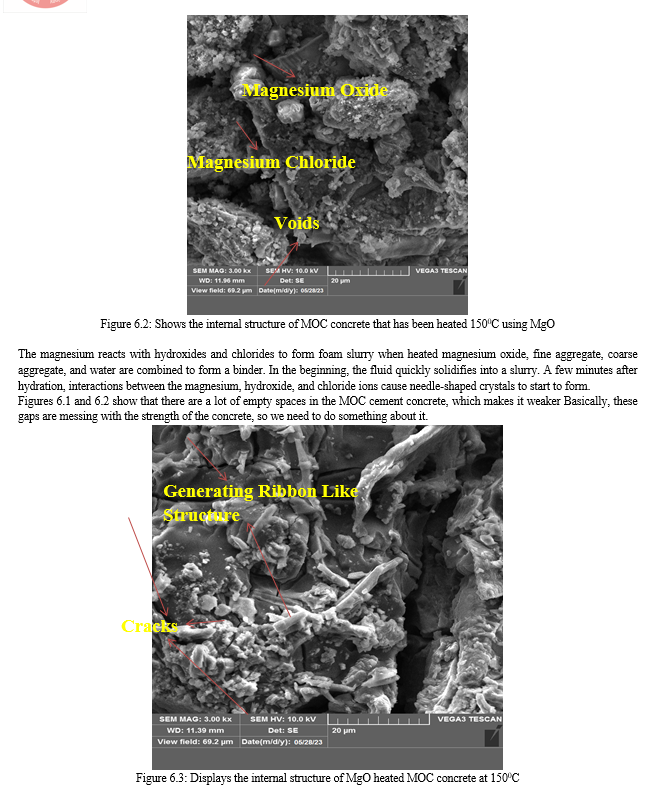
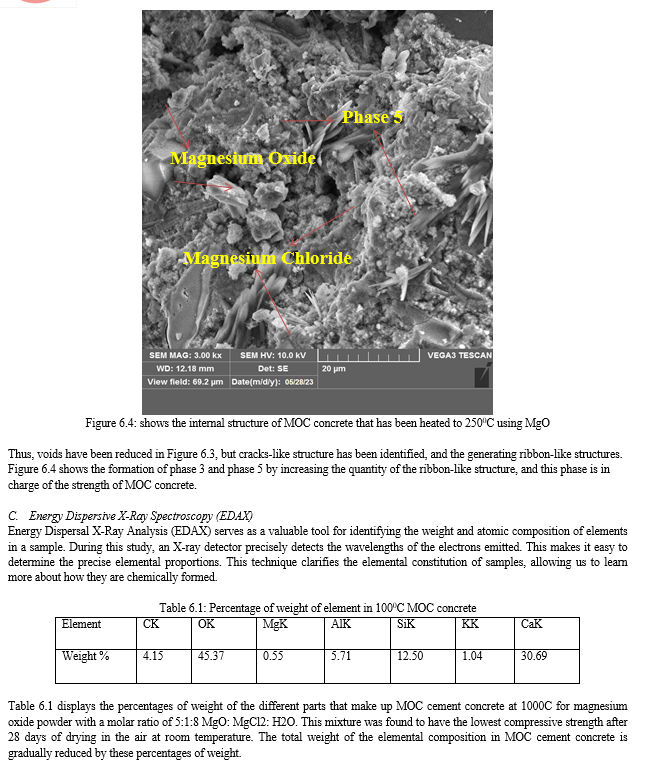
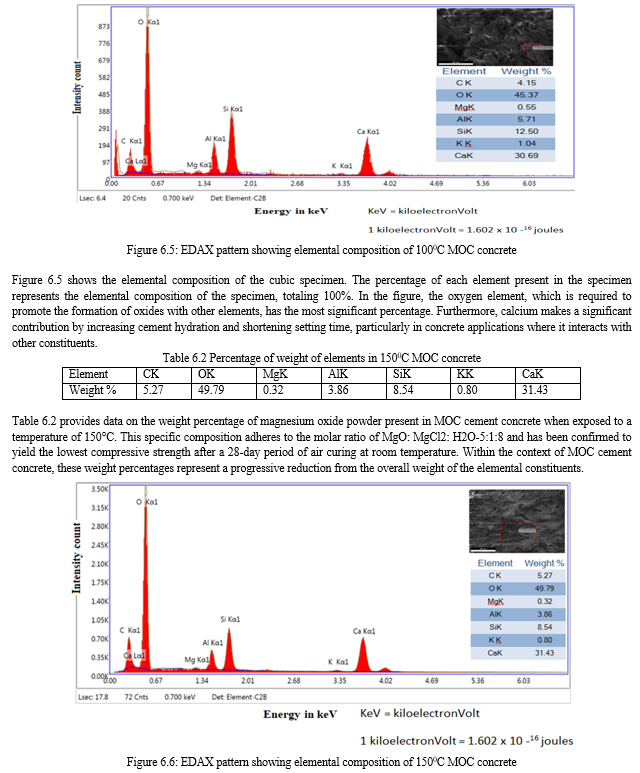
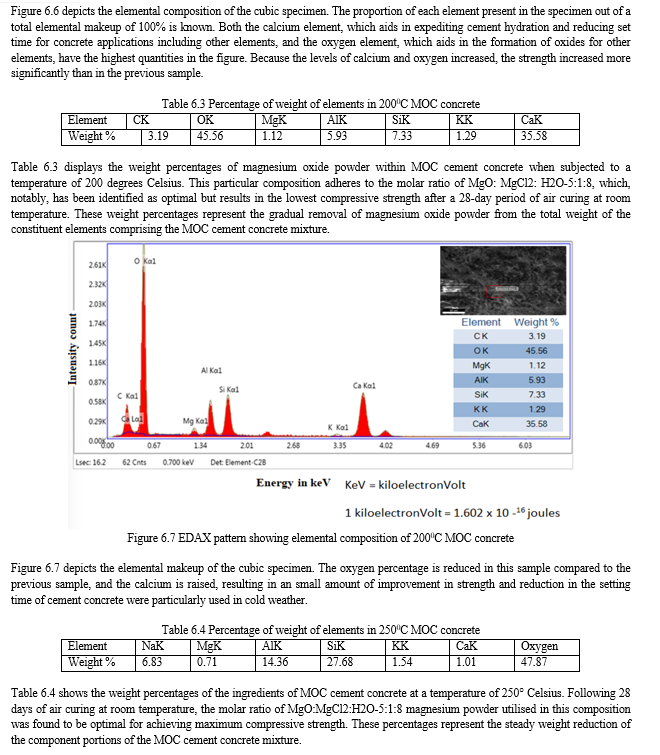

Figure 6.8 clearly show the cube's elemental composition. This representation depicts the fraction of each element contained in the specimen, which account for 100% of its elemental composition. The figure shows oxygen as the most prevalent element. It plays an important role in the production of oxides for other elements. Silicon is also vital for improving the object's qualities, particularly in terms of compressive strength, bond strength, and abrasion resistance, as well as for connecting to other elements.
D. Summary Of Work
To investigate the microstructure, Scanning Electron Microscopy (SEM) was employed, allowing for a comprehensive analysis. To enhance the quality of the results, SEM images were captured at multiple scales. These images were instrumental in documenting the various morphological structures that contribute to both the positive and negative effects on MOC cement concrete. Specifically, the SEM images were obtained at different temperatures during the heating process of magnesium oxide powder, which is a key component in 5-phase molar ratio MgO: MgCl2: H2O-5:1:8 MOC concrete. Additionally, the composition of elements and their respective proportions were graphically presented through Energy Dispersive X-Ray Analysis (EDAX).
Conclusion
A. Summary Of Work Following testing, some MgO oxide powder was heated at a temperature of 1000C for two hours before using it to cast the specimens. The specimens with the highest compressive strength at 2500C temperature, as well as the internal microstructure, were analyzed using SEM and EDAX. The following discoveries are the result of additional work. B. Conclusions 1) It is concluded that, for the preparation of MOC cement concrete magnesia powder has to be calcined to get good strength. 2) Calcination of MgO is been done at different elevated temperatures like 100, 150, 200 and 250 degree centigrade. 3) The mix proportions of the MOC concrete is taken as 1:1.5:3 and it is compared with OPC concrete. 4) The optimum MOC concrete is considered for an elevated temperature of 250 degree centigrade who’s compressive strength is more than that of OPC concrete. 5) The increase in strength of air dried MOC concrete which is heated at 250 degrees centigrade is analyzed using SEM and EDAX studies which says that the formation of phase-3, phase-5 long needle like crystal structures and in EDAX we observe the percentage of oxygen and silicon which leads to increase the strength. The current investigation found that magnesium oxychloride cement performed better than cement at a particular temperature. The final sample demonstrates the great compressive strength of OPC cement concrete at M20 grade. We can expect that heating MgO at higher temperatures will enhance its compressive strength. C. Future Scope Experimental data clearly reveal that subjecting magnesium oxide powder to higher temperatures during heating can greatly boost its strength qualities. However, the vulnerability of MOC cement to prolonged exposure to humid climatic conditions is a fundamental restriction that must be recognized. To reach its full potential in the construction business, it must overcome this barrier. Future research may look into the usage of reducers and super plasticizers as potential cures. Furthermore, due to its amazing resistance to high temperatures, MOC cement has a promising future in plasterboard construction, allowing a versatile application beyond its current limitations.
References
[1] A K misra and Renu Mathur on Magnesium oxychloride cement concrete, 2007. [2] Hongxia Qiao, Qianyuan Cheng, Wang Jinlei and Shi Yingying, The application review of magnesium oxychloride cement, 2014. [3] Hao Sun, a, Xiao Yang, a, Shun Wang, a, Zhanhua Kou, a, Silu Xie, an Experimental study on properties of magnesium oxychloride cement, 2018. [4] Chenggong Chang, Weixin Zheng, Jing Wen, Ying LI, Jinmei dong, Xueying Xiao, Qing Huang, Yangyang man, Magnesium Oxychloride Cement Prepared by the Byproduct of Li2CO3 from Salt Lake and Hydrochloric Acid, 2018. [5] Qing Huang, Weixin Zheng, Ying Li, Chenggong Chang, Jing Wen, Jinmei Dong and Xueying Xiao, The Effect of Doping High Volume Magnesium Sulfate on Properties of Magnesium Oxychloride Cement, 2022. [6] Michal Lojka, Anna-Marie Lauermannová, David Sedmidubský, Milena Pavlíková, Martina Zaleska, Zbysek Pavlík, Adam Pivák and Ond?rej Jankovský, on Magnesium Oxychloride Cement Composites with MWCNT for the Construction Applications, 2021. [7] Amal Brichni, Salima Aggoun, Halim Hammi, Adel Mnif, on Optimization of magnesium oxychloride cement properties by silica glass, 2016. [8] Milena Pavlikova, Adam pivak, Martina Zaleska, Anna- Marie Lauermannova, Filip Antonic, Michal Lojka, Ondrej Jankovsky, Zbysek Pavlik, on Assessment of wood chips ash as efficient admixture in foamed glass-MOC composites, 2022. [9] Chuanlin Hu, Biwan Xu, Hongyan Ma, Binmeng Chen, Zongjin Li, on Micromechanical investigation of magnesium oxychloride cement paste, 2015. [10] Anna-Marie Lauermannova, Michal Lojka, Ondrej Jankovsky, Ivana Faltysova, Milena Pavl?´kova, Adam Pivak, Martina Zalesk, Zby sek Pavli, on high-performance magnesium oxychloride composites with silica sand and diatomite, 2021. [11] Xueru Luo, Wenqiang Fan, Chunqing Li, Yong Wang, Hongjian Yang, Xiaoli Liu, Shaoming Yang, Effect of hydroxyacetic acid on the water resistance of magnesium oxychloride cement, 2020. [12] N. Clament Sagaya Selvama, R. Thinesh Kumar, L. John Kennedy, J. Judith Vijayaa, Comparative study of microwave and conventional methods for the preparation and optical properties of novel MgO-micro and nano-structures, 2011. [13] WEN Jing, YU Hongfa, LI Ying, WU Chengyou, DONG Jinmei, on Effects of Citric Acid on Hydration Process and Mechanical Properties of Thermal Decomposed Magnesium Oxychloride Cement, 2013. [14] Pan Liu, Jinmei Dong, Chenggong Chang, Weixin Zheng, Xiuquan Liu, Xueying Xiao and Jing Wen, The preparation of Low-Cost Magnesium Oxychloride Cement Using Magnesium Residue Byproducts from the Production of Lithium Carbonate from Salt Lakes, 2021. [15] Chenggong Chang, Lingyun An, Rui Lin, Jing Wen, Jinmei Dong, Weixin Zheng, Fengyun Yan and Xueying Xiao, Effect of Calcination Temperature on Mechanical Properties of Magnesium Oxychloride Cement, 2022. [16] Yuanji Chen, Chengyou Wu, Cong Chen, and Fangyu Chen, Effect of Portland cement on Magnesium Oxysulfate Cement Using Light-burned Dolomite, 2018. [17] Xiangchao Zeng, Hongfa Yu, Research on technology of performance improvement of basic magnesium sulfate cement (BMS), 2020. [18] Baki Aykut Bilginer, Sinan T. Erdogan, Effect of mixture proportioning on the strength and mineralogy of magnesium phosphate cements, 2021.
Copyright
Copyright © 2024 Danthuri Karthik Goud. This is an open access article distributed under the Creative Commons Attribution License, which permits unrestricted use, distribution, and reproduction in any medium, provided the original work is properly cited.

Download Paper
Paper Id : IJRASET58170
Publish Date : 2024-01-25
ISSN : 2321-9653
Publisher Name : IJRASET
DOI Link : Click Here
 Submit Paper Online
Submit Paper Online

